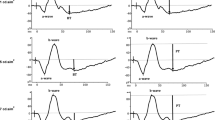Abstract
The study investigated the effect of three distinct types of stimulus configuration on the format of the normal sensitivity gradient derived by computer assisted perimetry namely: projected stimuli; light emitting diodes (LED) with the same luminance as the perimeter bowl; and ‘black hole’ LED stimuli. The study comprised two separate parts: 22 age matched subjects were examined with the Dicon AP3000 and with the Topcon SBP-1000 along the 15°–195° meridian of the visual field of the right eye; a further 22 subjects matched for age and gender were examined along the same meridian in an identical manner with the Dicon AP2025 and with the Humphrey Field Analyser 620. The various stimulus parameters were chosen in order to provide uniformity as far as possible between the instruments. The Topcon evoked greater relative sensitivity than the Dicon at all eccentricities although the rate of change of sensitivity with increase in peripheral angle varied between the two instruments at different locations. Centrally the Dicon profile followed more closely that of Humphrey stimulus size II and beyond 5° that of stimulus size I. The Topcon profile followed that of the Humphrey stimulus size II both centrally and peripherally in spite of being geometrically closer to the size III stimulus. It is proposed that the variations in the sensitivity gradient are not exclusively related to stimulus size and spatial summation; the accommodative stimulus of the ‘black hole’ LED stimuli, stimulus colour and thresholding strategy may all be contributing factors.
Similar content being viewed by others
References
Aulhorn E, Harms H. Visual perimetry. In: Jameson D and Hurvich LM (eds) Handbook of Sensory Physiology Vol VII/4. Berlin, Springer Verlag, 1972; 102–145
Fankhauser F, Schmidt TH. Die optimalen Bedingungen fur die Untersuchung der raumlichen Summation mit stenhender Reizmarke nach der Methode der quantitativen Lichtsinnperimetrie. Ophthalmologica 1960; 139: 409–423
Hart WM, Gordon MO. Calibration of the Dicon autoperimeter 2000 compared with that of the Goldmann perimeter. Am Ophthalmol 1983; 96: 744–750
Heijl A. The Humphrey Field Analyser, construction and concepts. Docum Ophthalmol Proc Series 1985; 14: 243–250
Jacka D, Personal communication, Coopervision
Johnson CA, Keltner JL, Balaesstray F. Effects of target size and eccentricity on visual detection and resolution. Vision Research 1978; 18: 1217–1222
Johnson MA, Massoff RW. The effect of stimulus size on chromatic thresholds in the peripheral retina. Docum Ophthalmol Proc Series 1982; 33: 15–18
Kani K, Tago H, Kobayashi K, Shiori T. A new automatic perimeter. Docum Ophthalmol Proc Series 1985; 14: 69–75
Lovasik JV, Personal communication. University of Waterloo, Ontario, Canada. N2L 3G1. 1987
Mills RP. Quantitative perimetry: Dicon. In: Drance SM, Anderson D. Automatic perimetry in glaucoma. A practical guide. Grune and Stratton Inc Orlando Florida. 1985
Sloan LL Area and luminance of test object as variables in examination of the visual field by projection perimetry. Vision Research 1961; 1: 121–138
Wild JM, Wood JM, Flanagan JG. Spatial summation and the cortical representation of perimetric profiles. Ophthalmologica 1987; 195: 88–96
Reference
Britt JM, Mills RP. The black hole effect in perimetry. Invest Ophthalmol Visual Sci 1988; 29: 795–801
Author information
Authors and Affiliations
Rights and permissions
About this article
Cite this article
Flanagan, J.G., Wild, J.M. & Wood, J.M. Stimulus configuration and the format of the normal sensitivity gradient. Doc Ophthalmol 69, 371–383 (1988). https://doi.org/10.1007/BF00162750
Accepted:
Issue Date:
DOI: https://doi.org/10.1007/BF00162750




